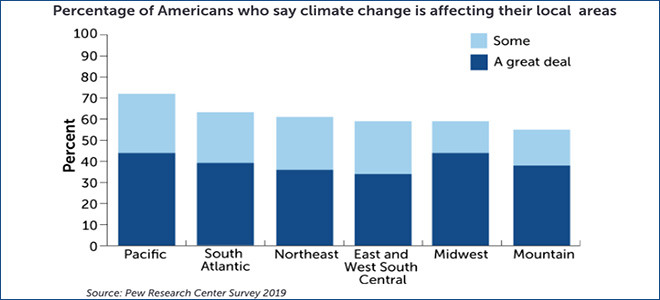
ScienceNews
by Gloria Dickie
Amid deadly wildfires in California and increased flooding along the U.S. East Coast in 2019, most Americans say the effects of climate change are already upon us — and that the U.S. government isn’t doing enough to stop it, according to a new public opinion survey.
In the nationwide poll, 62 percent of U.S. adults said climate change is affecting their local community to some extent or a great deal, bringing more flooding and unusually warm weather, altering ecosystems, driving wildfires or exacerbating drought, the nonpartisan Pew Research Center in Washington, D.C., reports November 25. That’s slightly up from the 59 percent who said the same in Pew’s 2018 poll.
“What it looks like is happening is a larger portion of Americans are accepting that climate change is with us and poses a hazard,” says Risa Palm, an urban geographer at Georgia State University in Atlanta not involved in the study.
The results follow what many environmental activists consider a watershed year for climate change awareness, marked by student protests and a speech by 16-year-old Swedish activist Greta Thunberg chastising world leaders at the United Nations for ignoring climate science (SN: 3/14/19).
“This study finds some familiar patterns in the public divides over climate and energy issues, but also areas where opinion among political groups has shifted,” says Cary Funk, the director of science and society research at Pew.
The Pew survey — which questioned 3,627 randomly selected adults from October 1 to October 13 — also revealed how views vary between regional and demographic groups, as well as trends in what people think that action should look like. It has a margin of error of plus or minus 2.1 percentage points. Here are four big takeaways.
1. People’s views depend on where they live.
Those most likely to report local effects from climate change lived along the Pacific Coast, which is facing rising sea levels (SN: 9/25/19) and has battled deadly wildfires despite electricity blackouts aimed at preventing more fires (SN: 11/1/19). Among West Coasters, 72 percent said climate change is affecting their area either a great deal (28 percent) or some (44 percent). By comparison, the percent of people living in the Northeast, Midwest and South who said climate change was altering conditions where they live ranged from 59 percent to 63 percent.
Regional differences
Americans living in U.S. states along the Pacific Coast were most likely to say that climate change is affecting their local community either somewhat or a great deal. Residents of central mountain states were least likely to say they see climate change effects in their backyards.
Whether people lived near a coastline also mattered. About 67 percent of respondents living within 40 kilometers of a coast said they saw local climate change effects. That coincides with a sharp rise in tidal flooding since 2000 along the U.S. East Coast (SN: 7/15/19). By comparison, 59 percent of people living more than 480 kilometers inland saw local climate change effects, including longer periods of unusually hot days, droughts and water shortages (SN: 6/5/19).
2. Most people think the U.S. government should do more.
A total of 67 percent said the government should be taking more action against climate change. That included strong support among Democrats (90 percent), as well as a big jump among liberal and moderate Republicans: 65 percent in that group are calling for more climate action, compared with 53 percent in the group in 2018. Younger Republicans were also more likely than older Republicans to say they wanted to see more action from the government. Views among conservative Republicans on this issue were only slightly changed, with 24 percent supporting more government climate action versus 22 percent in 2018.
“If Republican leaders don’t take [climate and energy] more seriously, it’s possible young voters may shrug and say ‘OK, Boomer,’ the next time they ask for their vote,” said John Kotcher, a communications researcher at George Mason University’s Center for Climate Change Communication in Fairfax, Va.
3. Most believe U.S. energy policy priorities need to change.
More than three-quarters, or 77 percent, of respondents said the United States needs to wind down its production and use of fossil fuels, the source of most climate-warming carbon emissions (SN: 7/1/19). To achieve that, 92 percent favor expanding solar power, and 85 percent want more wind power. Meanwhile, support was far lower for nuclear power (49 percent), offshore oil and gas drilling (42 percent), coal (35 percent) and hydraulic fracturing, which yields natural gas (38 percent).
The survey “helps us put our finger on the proverbial pulse of public sentiment,” says Max Boykoff, director of the Center for Science and Technology Policy Research at the University of Colorado Boulder. “We need to understand where people are on these issues, and find that common ground” to move forward with climate and energy policy. Read more …

